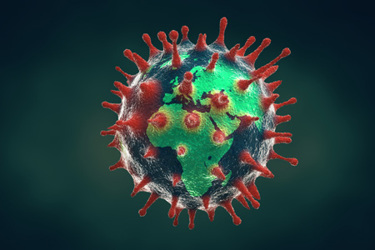Infection Control In The Era Of Smartphones And COVID-19
By Simon Philpott, Sumo Technologies

The broad availability and use of smartphones has not only revolutionized society, but also the way we conduct business. The healthcare industry is no different and has capitalized on the use of smartphones and mobile apps for healthcare workers. The World Health Organization found that mobile devices are used by approximately 90 percent of healthcare workers during the workday. Suppliers of many of the solutions for managing, caring, and interacting with patients also have responded by extending their software beyond the desktop, appearing as apps for deployment on smartphones.
But allowing healthcare staff to utilize their personal equipment at work increases the risk and impact of Hospital Acquired Infections (HAIs) contracted because of healthcare workers spreading bacteria and viruses through the use of their smartphones. Addressing the issue of HAIs contracted due to mobile device use is paramount during the current Coronavirus pandemic and is an important matter that needs to be mitigated within healthcare settings on an ongoing basis.
Smartphones Are A Breeding Ground For Bacteria And Viruses
Dr. Mary Lou Manning conducted a study titled, iPads, droids, and bugs: Infection prevention for mobile handheld devices at the point of care. In her analysis, Manning states, “Multiple investigators have shown that healthcare workers mobile devices provide a known reservoir of pathogenic bacteria, with the potential to undermine infection control efforts aimed at reducing bacterial cross-contamination. This potential could be amplified further as HCWs begin to carry additional personal electronic devices such as MHDs (Mobile Health Documents) without concurrently providing appropriate protocols on decontamination, especially at the point of acute care.”
Studies by academics such as Dr. Simon Park, Senior Lecturer in Molecular Biology, University of Surrey, revealed that 98 percent of smartphone touch screens have 25,000 germs per square inch. Pathogens such as Streptococcus, E-Coli, C-Diff, and MRSA have all been found on smartphones brought by staff into clinical areas. Another study found that out of 213 mobile phones being used by clinicians in intensive care units, pediatric intensive care units, and neonatal care units 73.7 percent (157) were colonized. In 2011 alone, approximately 722,000 HAIs were contracted in acute care settings in the U.S. and approximately 75,000 of these patients died.
Soap, Water And Disinfect Wipes Don’t Work
Although soap, water, and disinfect wipes can be used to keep a phone clean, healthcare workers need to remember to regularly clean their device multiple times per shift. Many clinicians only clean their phone when it is visibly dirty, or not at all due to advice from device manufacturers not to clean phone surfaces with disinfectant or abrasive solutions that may affect screen quality. This was even found with devices that have an IP67 rating or better.
Even in clinical environments that have adopted extensive mobile device cleaning protocols, there is still cause for concern as Yuval Cavari from the Pediatric Intensive Care Unit at Soroka Medical Center revealed in a study that found, “Eighty-nice participants were aware that mobile phones could be a source of contamination, yet only 13 disinfected their cell phone regularly.”
More concerning are the results from an orthopedic surgery room before and after decontamination. Of fifty-two cell-phones sampled, 94 percent (49) bore colony-forming units (CFUs) before decontamination, but surprisingly 75 percent (39 cell phones) were still contaminated after cleaning!
Ultraviolet Radiation And Phone Covers
Some practitioners are mitigating the risk of HAIs through the use of devices designed to sanitize phones using ultraviolet-C (UV-C) radiation without damaging the integrity of touch screens or other components. The results are a marked decrease in the presence of pathogens on these devices, but this approach is costly and complex to implement - as it requires procedures and protocols to enforce widespread use unless hospitals take the same approach as airlines by screening everything and everyone.
What about phone covers? Phone covers can provide some protection, but many have been known to harbor bacteria at the point where the cover meets the device. In addition, covers for smartphones are cumbersome and often restrict the use of the phone in some way.
The Solution Is Not Science
A relatively straightforward solution is to implement a separation of personal and business devices (phones, tablets, and laptops) with only purpose-built medical devices allowed within the hospital environment and any clinical area.
Unlike consumer mobile devices that collect and harbor pathogens, there are medical-grade tablets, laptops, and medical cart computers designed with durable, anti-microbial materials. Anti-microbial agents inhibit the ability of microorganisms to grow on the surface of a material. Purpose-built medical-grade tablets and computers are bacteria-resistant and help mitigate the spread of pathogens within a clinical environment. In addition, these mobile devices - like other equipment in the hospital - can be physically cleaned regularly.
With this approach, each healthcare worker does not need his or her own device. Calls can be routed to a specific person using thin client technology along with modern communication solutions.
Now Is The Time
Mobile devices are essential in providing and recording the correct information at the point-of-care to improve efficiency, reduce costs, and enhance the patient experience. Yet the evidence of contamination associated pathogens on mobile devices is overwhelming, along with the lack of cleaning and sanitization.
With the worldwide spread of Coronavirus upon us, healthcare organizations must consider dedicated mobile devices designed with anti-microbial material to mitigate COVID-19 infections acquired in healthcare environments.
About The Author
By Simon Philpott, VP of Marketing at Sumo Technologies a reseller of DT Research anti-microbial medical grade computing systems.
